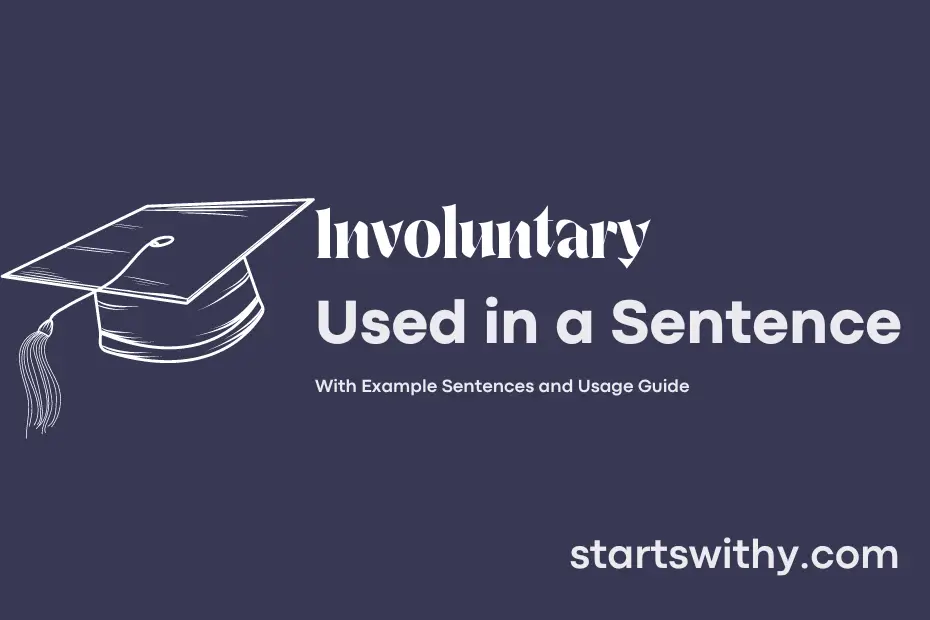Have you ever wondered what it means when something is described as “involuntary”? In the realm of actions and reactions, this term refers to actions or processes that occur without conscious control or intention.
Whether it’s a reflex, a physiological response, or a reflexive movement, involuntary actions are not within our voluntary control. This distinction is crucial in understanding various bodily functions and behaviors, shedding light on the complex interplay between conscious and unconscious processes.
7 Examples Of Involuntary Used In a Sentence For Kids
- Sometimes our bodies do involuntary things like sneezing or blinking.
- When we sleep, our breathing is involuntary.
- Crying when we are sad is an involuntary reaction.
- Hiccups are a funny involuntary action that happens to everyone.
- Your heartbeat is an involuntary function of your body.
- Yawning is another example of an involuntary action.
- Blushing when we feel embarrassed is an involuntary response.
14 Sentences with Involuntary Examples
- Involuntary muscle twitching can sometimes occur due to fatigue or stress during exam season.
- Cold showers can sometimes cause an involuntary shiver reaction in the body.
- Yawning is often an involuntary response to tiredness or boredom in class.
- Sneezing is an involuntary reflex that helps clear the nasal passages.
- The body’s involuntary response to sudden loud noises is often a startle reflex.
- Blushing can be an involuntary reaction to embarrassment or nervousness.
- The feeling of nausea can sometimes lead to an involuntary gag reflex.
- The urge to scratch an itch is often an involuntary response to a minor skin irritation.
- Hiccups are involuntary contractions of the diaphragm muscle that can be triggered by various factors.
- Crying can be an involuntary emotional response to stress, sadness, or frustration.
- Nervous laughter is often an involuntary reaction to uncomfortable situations.
- Teeth chattering in cold weather is an involuntary physical response to maintain body heat.
- The reflex to close your eyes when something approaches your face is involuntary to protect the eyes.
- The body’s involuntary response to dehydration is often a feeling of thirst.
How To Use Involuntary in Sentences?
To involuntary is to do something without conscious control or will. When using involuntary in a sentence, it is important to remember that this word typically describes actions or reactions that happen automatically, without intention.
Here are a few examples to help you understand how to use involuntary correctly:
- “She couldn’t stop the involuntary tears from falling down her cheeks.”
- “His involuntary flinch showed his fear of the sudden loud noise.”
- “The patient’s involuntary muscle spasms were causing discomfort.”
When incorporating involuntary into a sentence, think about actions or responses that happen without your conscious decision. It is often associated with reflexes, emotions, or physical reactions that occur naturally, without deliberate thought.
Remember that involuntary is used to describe actions that are not controlled by your conscious mind. By paying attention to the context of the situation, you can choose the appropriate words to express the idea of something happening automatically or instinctively. Practice using involuntary in various sentences to become more comfortable with incorporating it into your everyday vocabulary.
Conclusion
In conclusion, sentences with the keyword “involuntary” demonstrate actions or feelings that are not done by choice or intention. They highlight situations where an individual has no control over their actions, such as involuntary muscle movements or emotions. These sentences underline the lack of voluntary control or decision-making in certain circumstances, emphasizing the automatic or uncontrolled nature of the behavior or feeling being described.
By using sentences with “involuntary,” we gain insight into instances where actions or reactions occur without conscious effort, illustrating the complex interplay between our minds and bodies. These examples help us understand the importance of acknowledging and addressing involuntary responses in different contexts, from medical conditions to emotional responses, to better navigate and comprehend the dynamics of human behavior and physiology.



